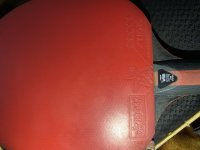This user has no status.
Member
what is the difference between hard european rubbers and chinese rubbers? for example between Rasanter 53 or mx p hard and the Hurricane 3 Neo 40 provincial?
in theory they have about the same degrees of hardness.
in theory they have about the same degrees of hardness.











